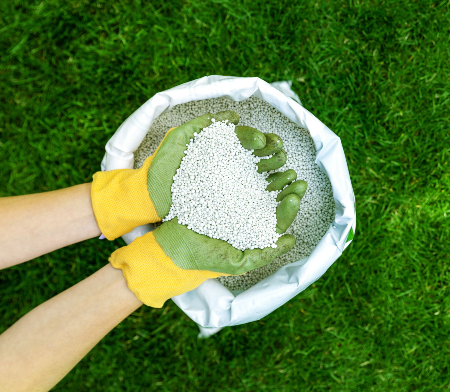- Lawn Turf
- Artificial
- Soil
- Timber
- Composite Decking
- Paving & Stone
Get In Touch With Our Experts Today!
Give us a Call! - Seed & Fertiliser
- Dressing
- Bark

July 02, 2024
Garden lawns are exposed to a lot of wear and tear, especially during the summer months: kids playing, pets sunbathing, family BBQs, and get-togethers with friends. And that’s before we mention the lawn care of mowing, edging, and de-weeding. It goes through a lot!
To maintain its gorgeous green shade, soft sward and healthy growth, your grass needs to absorb and store essential nutrients. One way to achieve this is by fertilising your lawn. Not every lawn needs fertilising, but there are signs to look out for that indicate your lawn could use a helping hand.
Grass is a living, breathing organism, and in order to grow efficiently, it needs the proper nutrients. Although a lot of these can be sourced organically through an established root system and regular rainfall and sunshine, sometimes the UK weather doesn’t play its part, which impacts the resources your lawn has access to. This is when you can support your lawn with a highly nutritious fertiliser.
There are two ways you can apply fertiliser to your lawn:
Lawn Fertiliser Top Tips
We recommend fertilising your lawn after mowing as this allows time to ensure the fertiliser has fully absorbed before mowing again. The soil also needs some moisture as fertiliser can scorch dry soil. So, if it hasn’t rained, water your turf before fertilising. Water your turf afterwards to wash any fertiliser off the grass blades and onto the soil where it can soak in. Don’t overwater; this could wash the fertiliser away, wasting your hard work.
Most fertilisers incorporate the main nutrients turf is hungry for – nitrogen to encourage plant rejuvenation, potassium to strengthen grass blades, and phosphorus to support root growth. A fertiliser with an even balance of all three provides a well-rounded solution for feeding your grass.
However, depending on your turf’s issues, you may want a higher concentration of one element. For example, more nitrogen in spring promotes healthy growth and a bright green colour ready for summer. Phosphorus, on the other hand, will strengthen grass roots, enabling them to access key nutrients during the winter season.
At George Davies, we have two lawn fertilisers we recommend to our customers:
As the name suggests, Envy fertiliser is ideal for springtime and is designed to enhance your lawn’s growth and colour. It increases the nitrogen content of your grass to establish stronger roots, encourage healthy growth, and keep your lawn looking fresh and vibrant during hot weather.
Nourish Autumn/Winter Fertiliser
These slow-releasing pellets are specifically designed to support your grass during harsh winters when sourcing food and nutrients is harder. It aids a healthy-looking lawn and maintains its strength, ready for spring.
When To Fertilise Your Lawn
You should think about incorporating fertiliser twice a year: once in spring as your lawn begins to wake up and once in autumn before it goes to sleep. These two applications will help protect your grass during challenging weather conditions and give it a boost of energy when it starts actively growing.
A mid-year application could also be beneficial if you notice your grass struggling due to hot weather or after heavy rainfall; this can cause essential nutrients to wash off the surface of your lawn rather than soak into the soil.
Although it may seem harmless to feed your lawn full of goodness, you can fertilise your lawn too much which can have a reverse effect. All fertilisers hold nitrogen, and too much nitrogen can kill your grass. If you start spotting yellow or brown patches, these are signs you’ve over–fertilised. Furthermore, applying fertiliser to dry soil can scorch the soil and not actually absorb into your grass roots. If you think you’ve applied too much fertiliser, wash it away and start the process again.
If you’re struggling with reviving your turf, speak with the George Davies team who can recommend the best lawn fertiliser for your type of turf.
CALL US NOW ON 01234 818 253